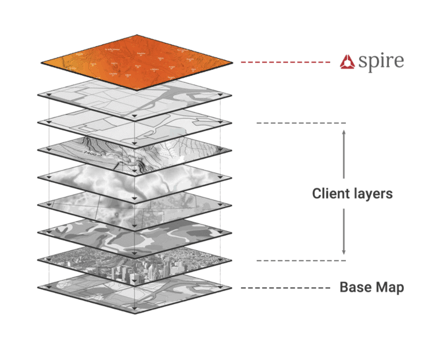An overview of the Weather WMS API usage and Web Map Service (WMS) data output.
WMS Overview and Style Walkthrough
A quick overview of Spire WMS can be found here.
A more detailed walkthrough of WMS visual styles and other capabilities can be found here.
Example Input:
https://api.wx.spire.com/ows/wms?request=GetMap&bundle=basic&version=1.3.0&width=3072&height=1536&crs=EPSG:4326&bbox=-90,-180,90,180&FORMAT=image/png&TRANSPARENT=true&EXCEPTIONS=application/vnd.ogc.se_inimage&styles=temp:K/nearest&layers=sof-d/20200308/12/t2m:K&TIME=2020-03-08T12:00:00.000Z&service=WMS
Output (WMS):
WMS (Web Map Service) is a standard created by the Open Geospatial Consortium to deliver map layers through the internet. It is defined in the OGC Web Services Context Document (OWS).
Spire's WMS layers are pre-styled, geo-referenced weather visualizations.
Simply put, they are images that can be displayed on a map:

For this reason, they are perfect for swift integration with existing geospatial software (i.e. applications with maps). There are many existing applications for working with WMS data.
Spire's WMS implementation allows users to choose from several different styles for each layer in order to compose multiple views of the same information. Visualizations are created for each valid time in a weather forecast, enabling users to select which time to view or play through all of them sequentially.
The following 2 videos both show the Spire Weather API being used to return WMS data.
The first video demonstrates integration with existing geospatial software (in this case, ArcGIS Online). It uses a much shorter URL than the one at the top of this article (https://api.wx.spire.com/ows/wms) since any software which supports the WMS standard will add necessary URL parameters without requiring them to be explicitly specified:
The second video uses the example API request from the top of the page. This URL is long because several parameters must be specified for the desired image format, time, and weather data variable. Please note that end users will not typically use the API in such a way. This is merely a test call to retrieve one image of one data variable at one time. However, it serves as a demonstration for what is happening behind the scenes when WMS is integrated with existing software such as ArcGIS, QGIS, Mapbox, or others:
Spire Weather also provides an open-source example for integrating WMS layers into a custom web application. This example uses OpenLayers as the map library for integration.
Example usage and links to code samples can be found here.